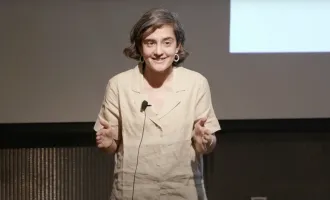Celebrating Accessible Science
The 11th annual Open Access Week was celebrated Oct. 22 to 28. Anneliese Taylor, Assistant Director for Scholarly Communications and Collections at the UCSF Library, spearheaded the celebration on campus, and described open access as the “immediate free availability of scientific material, available for everyone.”
Events took place both on campus and at neighboring companies and served to educate the scientific community as well as be a venue for faculty and students to voice their concerns and ask questions about open access publishing and platforms.
Screening of “Paywall: The Business of Scholarship” Movie, hosted by the Public Library of Science (PLOS); Oct. 23
Attendees had the opportunity to drink, meet others interested in open access, and grab some popcorn before watching the documentary.. There’s a pause at the beginning of the documentary asking the viewer for money in order to access its content, thus simulating the experience people without journal subscriptions encounter when trying to access and article. Although mostly presenting the perspectives of academics who are pro open access, the documentary aims to inform its audience about the economic and intellectual monopoly held by publishing companies and to expose the reasons why people are against them.
In a room full of people that already support the cause, watching the documentary opened up the discussion of what’s been done, what is being done, and all the possibilities of what could be. Talking to other graduate students from UCSF present at the event, it seems like we are in agreement: open access makes sense. It felt like a general consensus that making our research openly available and accessible would benefit many people. On one hand, it would allow us to share our data with anyone interested in the field, promoting the advancement of knowledge. For example, patients interested in staying up to date with the research in certain areas of medicine would have access to it. Open access would also help with disparities encountered by institutions: freely accessible articles are for everyone, allowing students from institutions that can’t afford certain journal subscriptions to obtain the information. This discussion, spanning over many different topics such as economics and intellectual property, was continued the next day in an event hosted by the UCSF Library.
Getting Ahead with Open Access, hosted by the UCSF Library; Oct. 24
The panel included Liz Silva, PhD, Associate Dean of Graduate Programs, Rich Schneider, PhD, Associate Professor in the Orthopedic Surgery Department, and Ivy Anderson, Director of the Collection, Development, and Management Program at the California Digital Library. A very dynamic trio, passionate about educating the attendees about Open Access, its history, how its perceived by different academics, and the University of California’s efforts towards open access.
The amount of money spent annually by the UC Library in order for us to get access to scientific journal is in the tens of millions. As was mentioned in the “Paywall” documentary, libraries need subscriptions to multiple journals, we cannot decide on one or the other, it has to be both. These are costs that not all institutions have and the availability of these scientific resources is often limited to bigger institutions. Conversations about open access began around three decades ago, and at UCSF, the Academic Senate passed the Open Access Policy for UCSF in 2012. In 2013, the system wide policy was passed, promoting the open availability of research articles by scientists from all UC institutions. UCSF, along with several other UC institutions, is part of Open Access 2020, a world-wide initiative towards open access. This initiative looks to change the way journal’s current subscription-based accessibility into open access not by creating new expenses for the institutions but by converting what’s already spent into open availability of the information. It also aims to get everybody involved: the academic institutions, the libraries, funders, and publishers.
Although the interest is there, it is still hard to convince faculty members to publish in open access journals. For some, the prestige of the journal, based largely on its’ impact factor, holds a lot of value and open access journals are not ranked high enough. Others worry about needing papers in those high-impact journals to get the ever-more competitive academic positions at their institution of interest. To keep the conversation going it’s important to voice all concerns about open access, whether it be doubts about the economical sustainability of this model or the effects of not publishing in high-impact journals. By talking and getting oriented by the correct people and resources we might be able to understand the model and what its goals are. There are many individuals fighting for open access, for the wide availability of science, and they are willing to engage with voices from all sides and work towards solutions that work for everyone.


